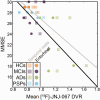Evaluation of [18F]-JNJ-64326067-AAA tau PET tracer in humans
- PMID: 34259071
- PMCID: PMC8669274
- DOI: 10.1177/0271678X211031035
Evaluation of [18F]-JNJ-64326067-AAA tau PET tracer in humans
Abstract
The [18F]-JNJ-64326067-AAA ([18F]-JNJ-067) tau tracer was evaluated in healthy older controls (HCs), mild cognitive impairment (MCI), Alzheimer's disease (AD), and progressive supranuclear palsy (PSP) participants. Seventeen subjects (4 HCs, 5 MCIs, 5 ADs, and 3 PSPs) received a [11C]-PIB amyloid PET scan, and a tau [18F]-JNJ-067 PET scan 0-90 minutes post-injection. Only MCIs and ADs were amyloid positive. The simplified reference tissue model, Logan graphical analysis distribution volume ratio, and SUVR were evaluated for quantification. The [18F]-JNJ-067 tau signal relative to the reference region continued to increase to 90 min, indicating the tracer had not reached steady state. There was no significant difference in any bilateral ROIs for MCIs or PSPs relative to HCs; AD participants showed elevated tracer relative to controls in most cortical ROIs (P < 0.05). Only AD participants showed elevated retention in the entorhinal cortex. There was off-target signal in the putamen, pallidum, thalamus, midbrain, superior cerebellar gray, and white matter. [18F]-JNJ-067 significantly correlated (p < 0.05) with Mini-Mental State Exam in entorhinal cortex and temporal meta regions. There is clear binding of [18F]-JNJ-067 in AD participants. Lack of binding in HCs, MCIs and PSPs suggests [18F]-JNJ-067 may not bind to low levels of AD-related tau or 4 R tau.
Keywords: Aging; Alzheimer’s disease; PET; [18F]-JNJ-067; tau.
Conflict of interest statement
Figures






References
-
- Braak H, Braak E. Neuropathological stageing of Alzheimer-related changes. Acta Neuropathol 1991; 82: 239–259. - PubMed
-
- Chien DT, Bahri S, Szardenings AK, et al.. Early clinical PET imaging results with the novel PHF-tau radioligand [F-18]-T807. J Alzheimers Dis 2013; 34: 457–468. - PubMed
-
- Hostetler ED, Walji AM, Zeng Z, et al.. Preclinical characterization of 18F-MK-6240, a promising PET tracer for in vivo quantification of human neurofibrillary tangles. J Nucl Med 2016; 57: 1599–1606. - PubMed
Publication types
MeSH terms
Substances
Grants and funding
LinkOut - more resources
Full Text Sources
Medical
Miscellaneous

